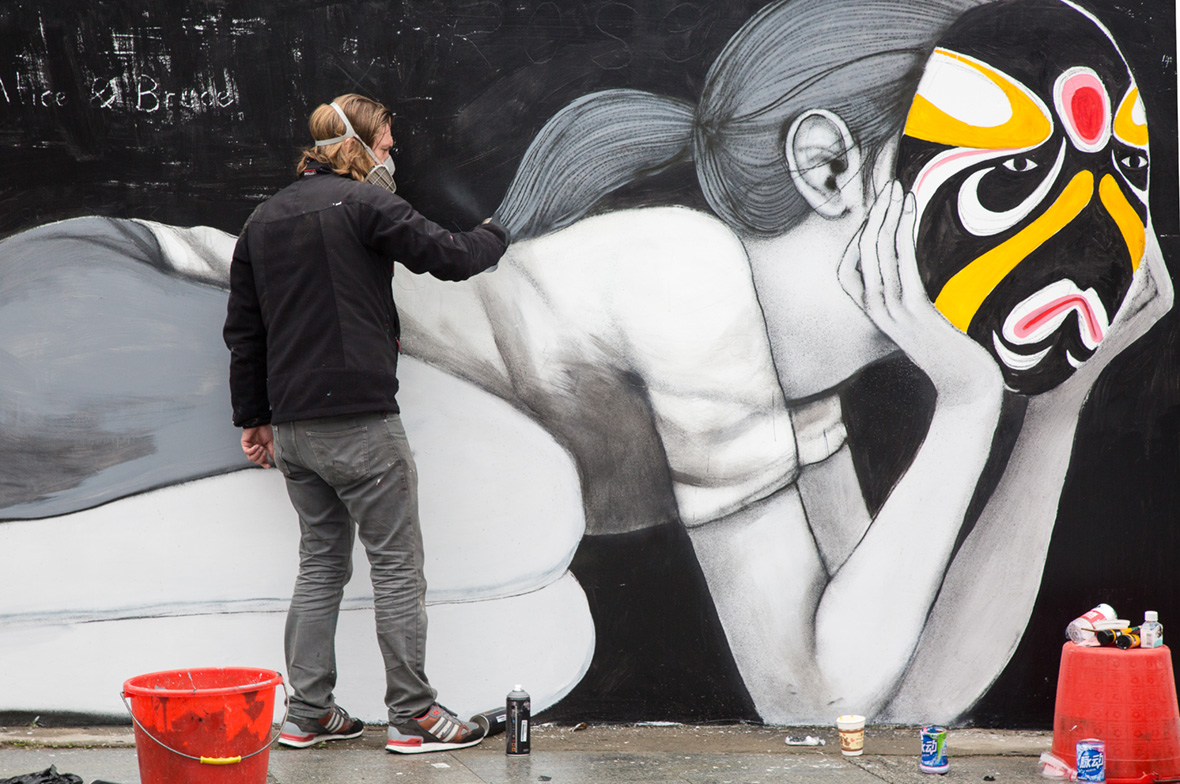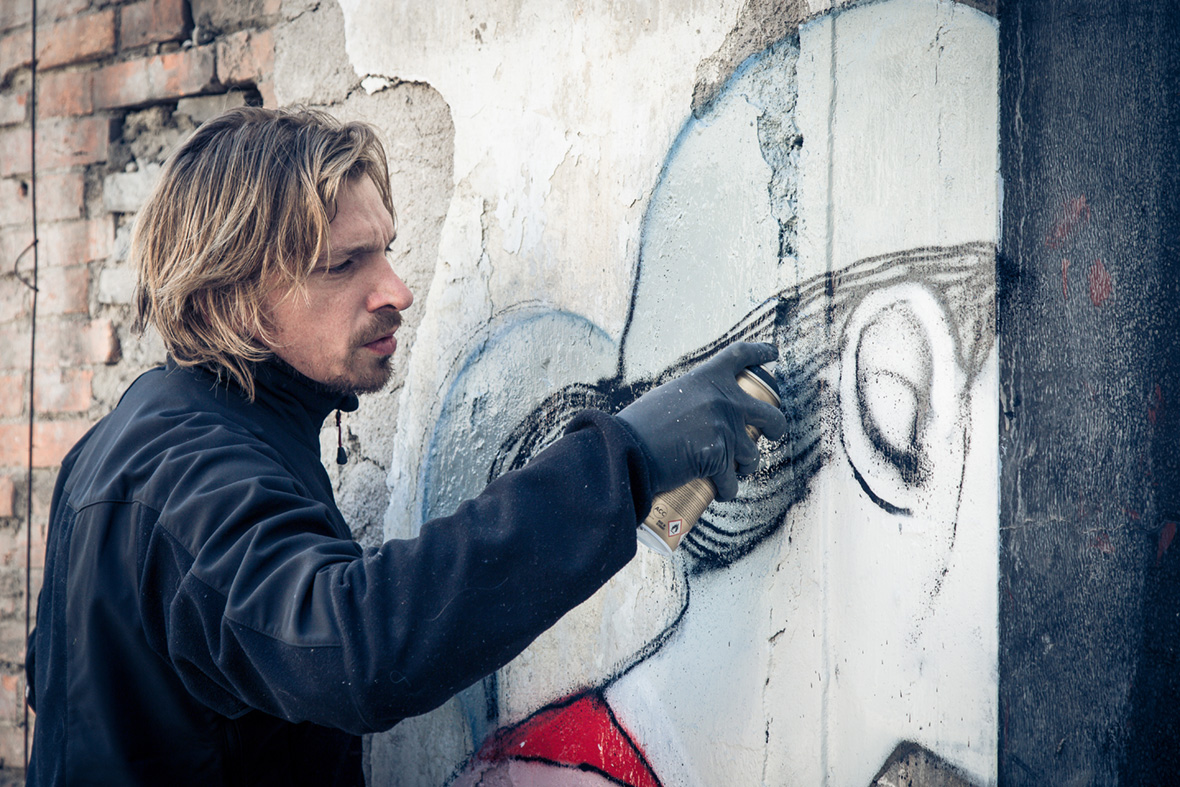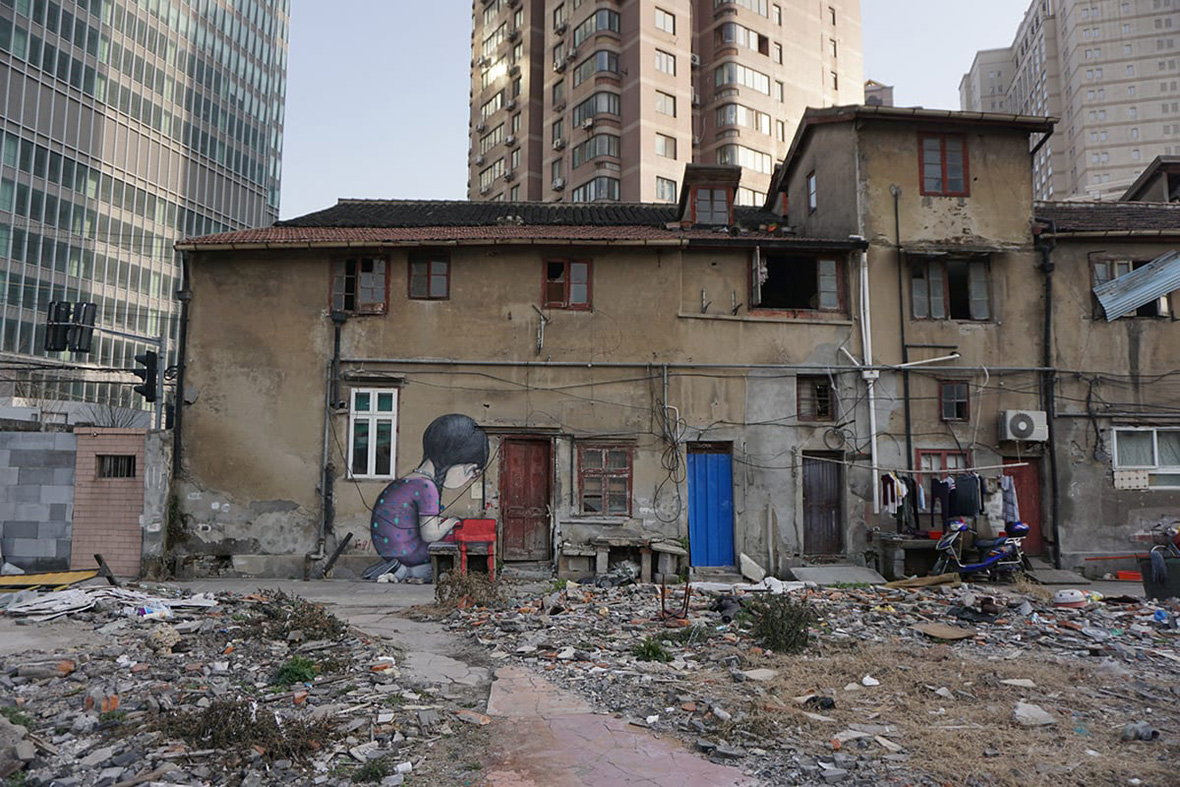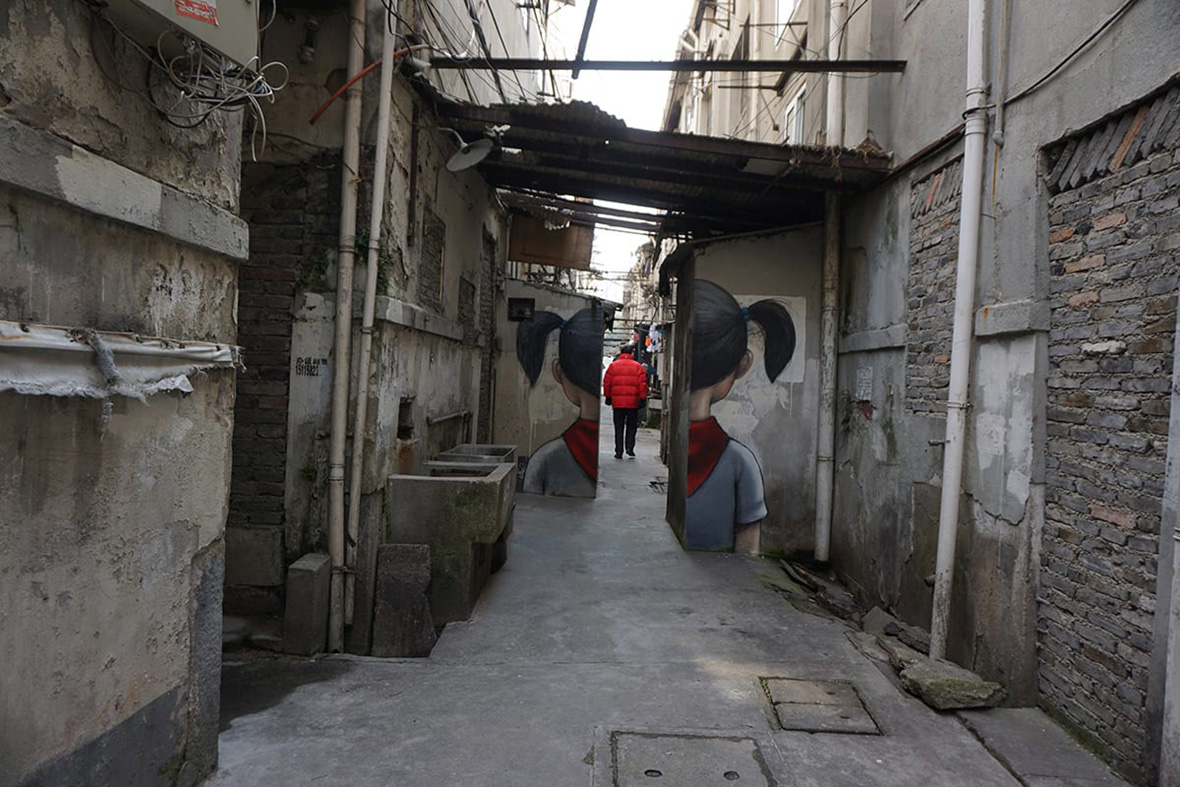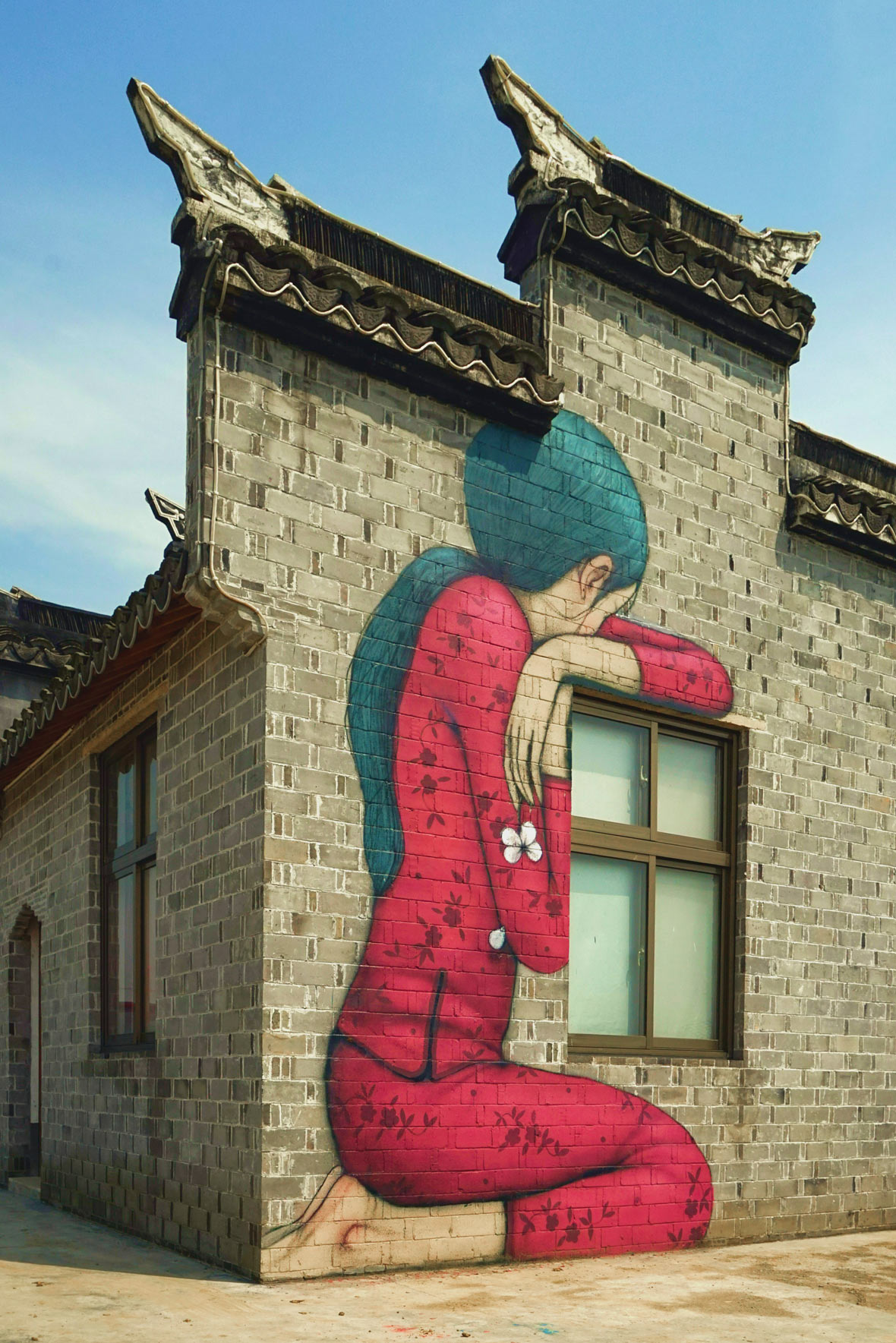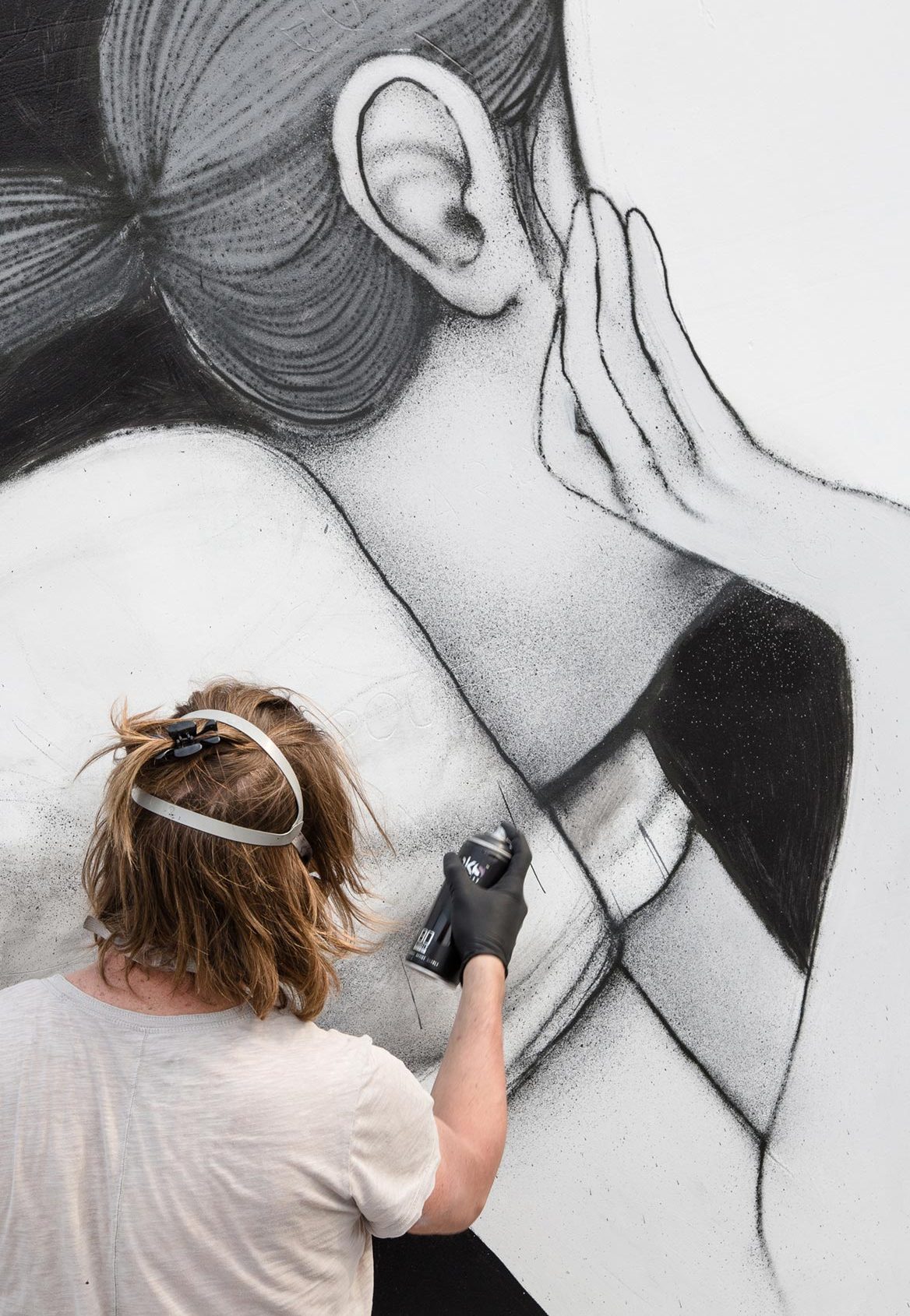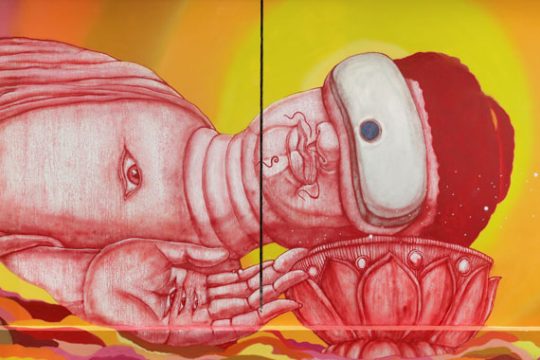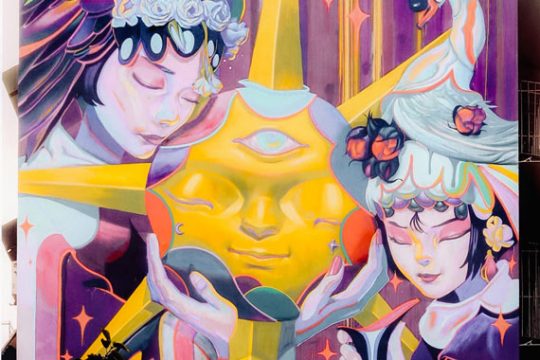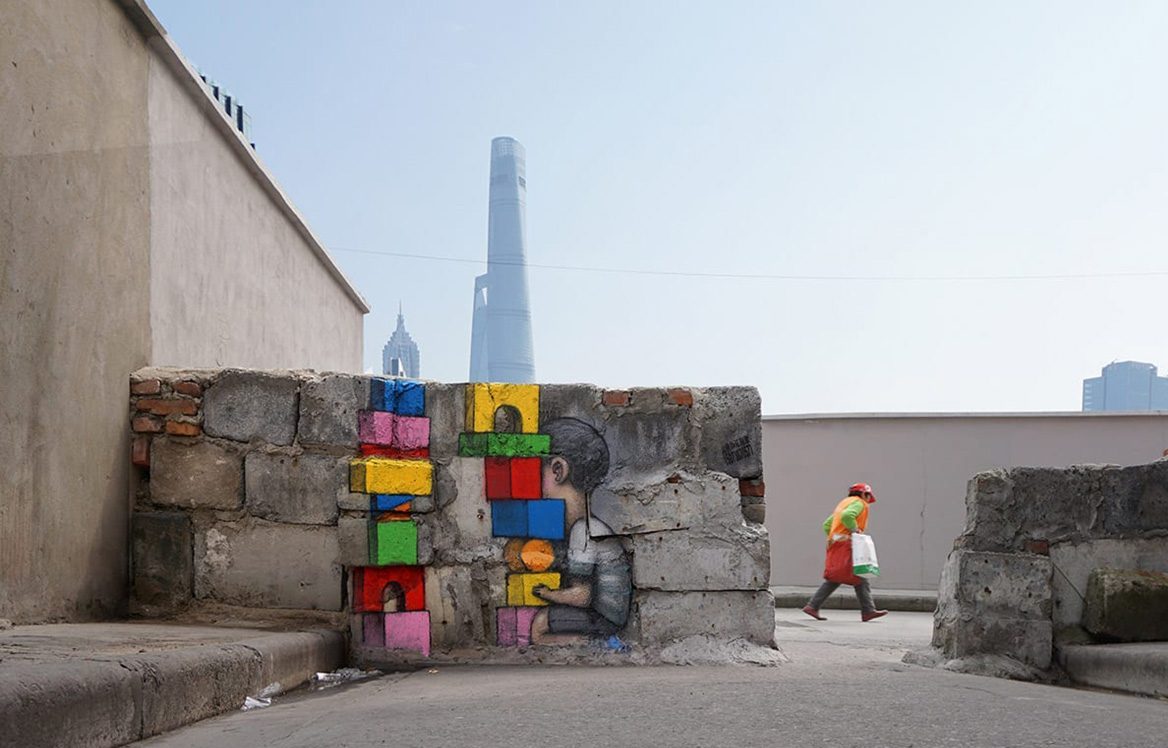
All around the world, French artist Julien Malland, who goes by the artistic name Seth Globepainter, brings dull and neglected walls to life by painting them with magnificent murals. He often portrays children, their faces turned away or covered in rainbows, as if they’re about to cross into a fantastic new world. Seth’s colorful street art shows a nostalgia for childhood and a sensitivity to context, and frequently involves the participation of nearby residents.
Born in 1974 in Paris, Seth first started tagging in the 1980s, and by the mid-1990s he was an active member of France’s graffiti circles. He went on to travel the world and discovered that through painting he could connect with people from different cultures. His travels led him to host eight episodes of the documentary series Les Nouveaux Explorateurs, in which he introduced different countries through graffiti.
在世界各地,法国艺术家 Julien Malland(又名 Seth Globepainter)以令人震撼的壁画,让那些沉闷、被荒废的墙壁重现活力。他的作品描绘的大多是小孩,他们扭过头或将脸埋在彩虹中,仿佛即将跨入一个梦幻的新世界。Seth 丰富多彩的街头艺术展示了对童年的怀念和环境敏感性,还常常会包括附近居民的参与。
Seth 于 1974 年在巴黎出生,从 80 年代开始创作涂鸦签名 tag,到了 90 年代中期,他已经成为法国一名活跃的涂鸦艺术家。之后 Seth 的足迹遍布世界,在旅途中,他发现画画可以让自己和来自不同文化背景的人相交流。有了这些旅行经历,他被邀请主持一个 8 集的系列纪录片《Les Nouveaux Explorateurs》(《新探索者》),通过涂鸦介绍不同的国家。
Seth has been coming to China for a long time, and his other nickname, Mr. Qi, is a translation of sorts of his artistic name. (In French, ‘Seth’ is a homonym for sept, or seven, which in Mandarin is qi.) When he first visited the country, he encountered a new and unique reaction to his work. “China doesn’t have a street-art culture like other Asian places, such as Japan or Thailand,” he explains. “Chinese people have a totally fresh curiosity when it comes to this form of expression, and that’s what’s motivated me to continue working in the country.”
Seth 来中国已经有很长一段时间,他的另一个外号“柒先生”是他艺名的中文翻译。法语里,“Seth”与“sept”谐音,意为 7,中文为“柒” 。当他第一次到访中国时,他发现当地人对自己的作品有一种截然不同的独特反应。“中国不像日本、泰国和其他亚洲地区那样有着街头艺术文化。”他解释说,“中国人对于这种艺术表达(涂鸦)有新鲜感和好奇心,这也促使了我继续在中国创作。”

In Shanghai alone, he’s created over 20 murals in public areas. Most of these he painted in old shikumen, the city’s traditional lane houses, many of which have been torn down to make way for high rises. Seth often paints amid the rubble, after the evacuation but before complete demolition, portraying characters from the lanes’ former bustling life. “I like to walk in these old parts of the city. That’s where I can find the last vestiges of old China, the one that has always fascinated me. My paintings are a way to debate the rapid transformation of the country.”
单是在上海,他就创作了 20 多幅墙绘,大多数都画在上海的传统弄堂建筑老石库门上,其中许多已被拆除,给高楼大厦让位。Seth 常常在居民迁出后,大楼被完全拆掉之前的瓦砾中创作,刻画出弄堂居民之前熙熙攘攘的生活。“我喜欢在上海的老城区逛,在那里,我可以找到始终让我着迷的、旧中国的痕迹。我的作品其实是对中国快速转型的讨论。”
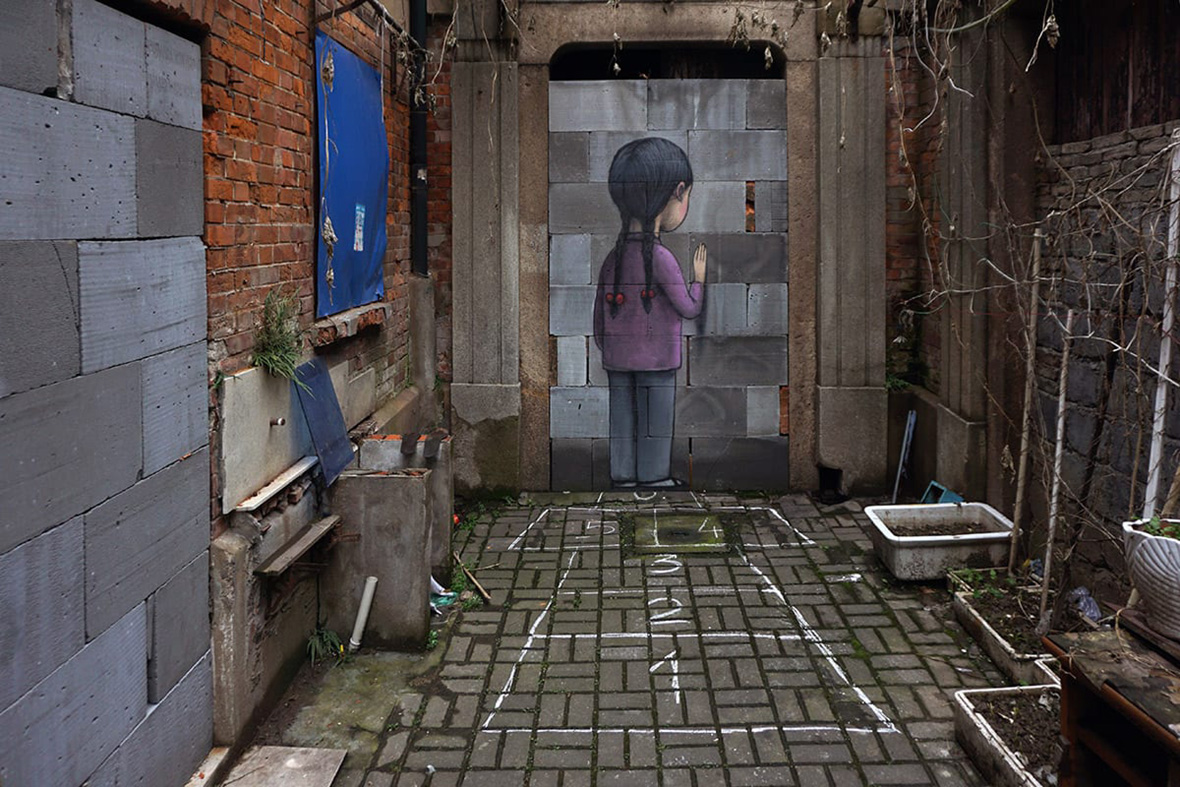

In 2018, he spent two months in the city for a residency at the Museum of Contemporary Art (MoCA). On a half-destroyed portico on Kangding Road, Seth painted two kids in the red scarves worn by all primary school students in China. It’s a simple but meaningful element that every Chinese person immediately recognizes and remembers. One block away, he painted another mural with a more melancholic air: a girl holding a tiny house in her arms. Her eyes are shut and she has a mournful expression as if trying to hold on to the home that she had to abandon.
2018 年,他作为上海当代艺术博物馆(MoCA)的驻地艺术家,曾在这座城市生活过两个月的时间。在康定路一座半毁的门廊上,Seth 画了两个戴着红领巾的小学生。在中国,所有小学生都会佩戴红领巾,这是一个简单而有意义的元素,每个中国人都能马上认出并记住。而在一个街区之外,他又画了一幅风格更为忧郁的壁画:一个小女孩手中抱着一幢小房子。她闭上了眼睛,透露出一种悲伤的表情,仿佛在试图抓住她不得不放弃的家。
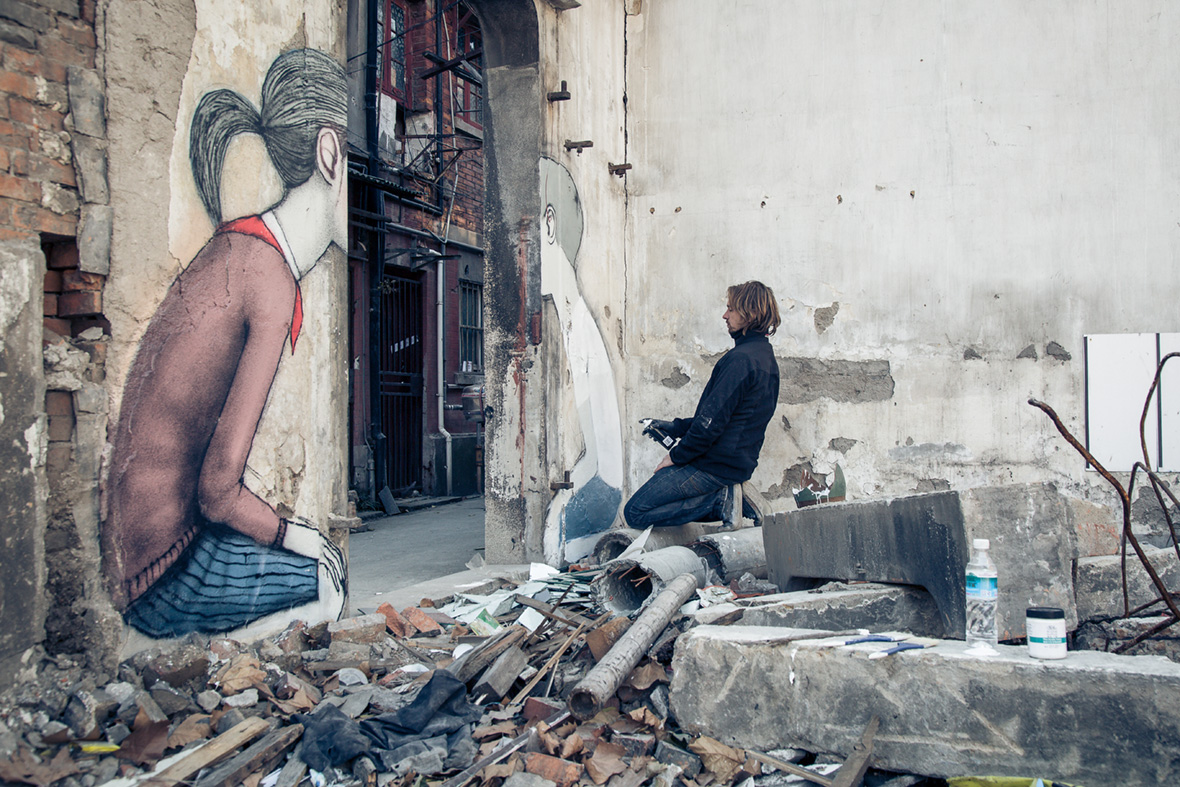
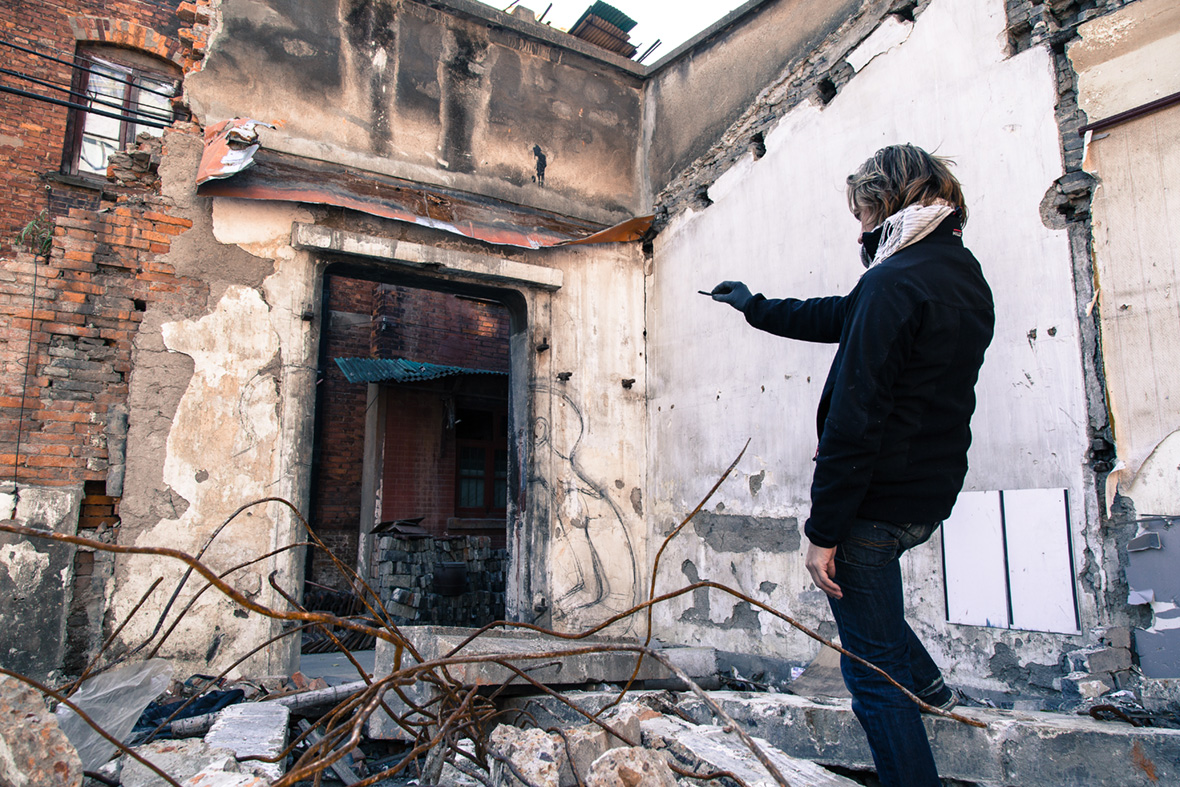
All of Seth’s works in these old neighborhoods were eventually covered or destroyed by the authorities. Yet he isn’t distressed about this fact: “I’m very interested in the fate of my paintings. If they are destroyed by the authorities or preserved by the communities, that says a lot about the places where they were made.”
Seth 在这些旧街区的作品最终都被当局覆盖掉或拆毁。然而,他并不心疼:“我很关心我的画的命运,不论是被当局销毁或被当地社区保留下来,这都能让人对当地有所了解。”
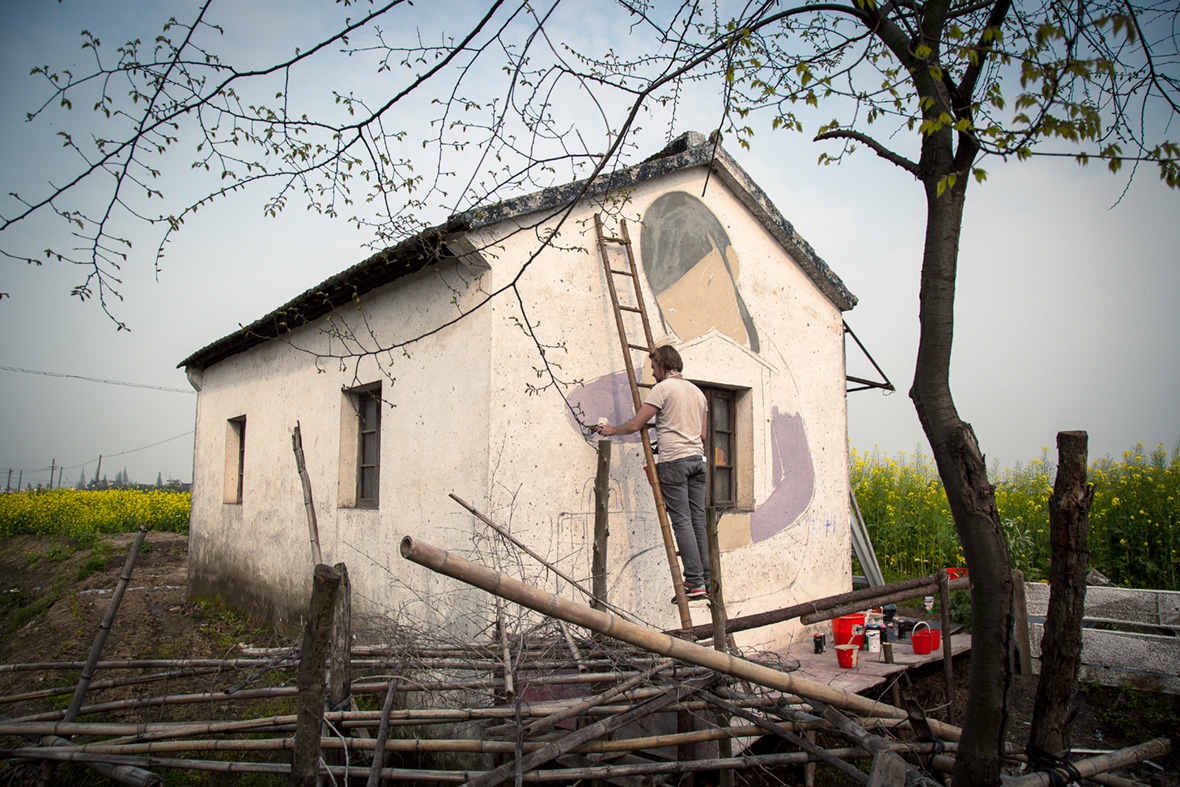
In Fengjing, a historic town near Shanghai, Seth’s works are still standing. They play with the architectural traits of the buildings and local history: a triangular roof forms a bamboo hat, representing rural culture; a window gives shape to another beloved home and, while held tight by a girl, it represents youth migration to urban centers. This series shows how Seth establishes an intense dialogue with the local population, which is for him the purpose of creating in public spaces: “Painting is a pretext. What counts is the exchange between the inhabitants and the artist,” he says. In Fengjing, Seth enlisted a local calligrapher to help him with the quotations from ancient philosophical texts that he incorporated into some of the murals.
在上海附近历史悠久的枫泾古镇,Seth 的作品存留至今。这些作品充分利用了当地建筑的特征和当地历史:一个三角形的屋顶形成一个斗笠,代表当地的乡村文化;一扇窗户构成了新家的轮廓,被一个女孩紧紧抓住,象征青年人迁移到城市中心。这个系列展示了 Seth与当地居民所建立的深层对话,这正是他在公共空间创作的目的:“绘画只是一个借口。重要的是居民和艺术家之间的交流。”他说。在枫泾,Seth 招募了一位当地书法家,帮他将中国古代哲学文献中的引文,加入到一些壁画中。
One of Seth’s more fascinating projects in China is Back to School. In order to bring art to the lives of kids from poor villages all over the country, he selected ten of the best street artists in the world—all of whom already had a connection with the theme of childhood—to create large murals in schools. This colossal project, which he carried out with the Shanghai-based curator Cao Bin, involved finding schools, understanding different communities, working with the authorities, and transporting the heavy equipment necessary to paint the huge walls.
Seth 在中国最引人入胜的项目之一是《Back to School》(回到学校)。为了让艺术走进中国各地贫困村庄的孩子的生活,他找了世界上十位最优秀的街头艺术家,他们的作品都与童年主题有关,然后邀请他们到学校里创作大型壁画。他与上海策展人曹彬一起开展了这个庞大的项目,包括寻找学校、了解不同的社区、与当局合作,以及运送在大幅墙壁上创作所必要的重型设备。

In a village near Mount Siguniang in Sichuan, Seth himself painted a mural five stories high depicting a local girl in the process of drawing a sketch that was given to him by the children of the school. He concentrated on the patterns and details of her traditional Sichuan costume, an elaborate painting work that wittily contrasts with the other childlike elements of the original sketch.
在四川四姑娘山附近一个村庄,Seth 自己在一幅五层楼高的墙壁上创作了一幅壁画,描绘了一个当地女孩画画的情景,而那副画中画则正是当时学校的孩子送给 Seth 的。他细致描画出女孩身上的传统四川服装的图案和细节,与原来那幅充满孩童风格的简单草图形成有趣的对比。
Each artist established a relationship with the local community and integrated their experiences to the murals. Not just the children but also their parents interacted with the artists, sharing music, food, and other aspects of their culture. “The presence of the artist was equally important for the grown-up population,” Seth notes. “They revisited their traditional roots. I believe they knew they’d live with the mural for a long time, so it was important to create a strong bond with its creator.”
每位艺术家都会与当地社区建立一定的关系,将自己的经历融入壁画的创作中。不只是孩子,小孩父母也会与艺术家有所互动:分享音乐、食物和他们其他方面的文化。“艺术家的存在对于成年人来说同样重要。”Seth 说,“这会让他们重新审视自己的传统根源。他们知道自己会与这些壁画一起生活很长一段时间,所以很有必要和壁画的创作者形成一个稳固的连接。”
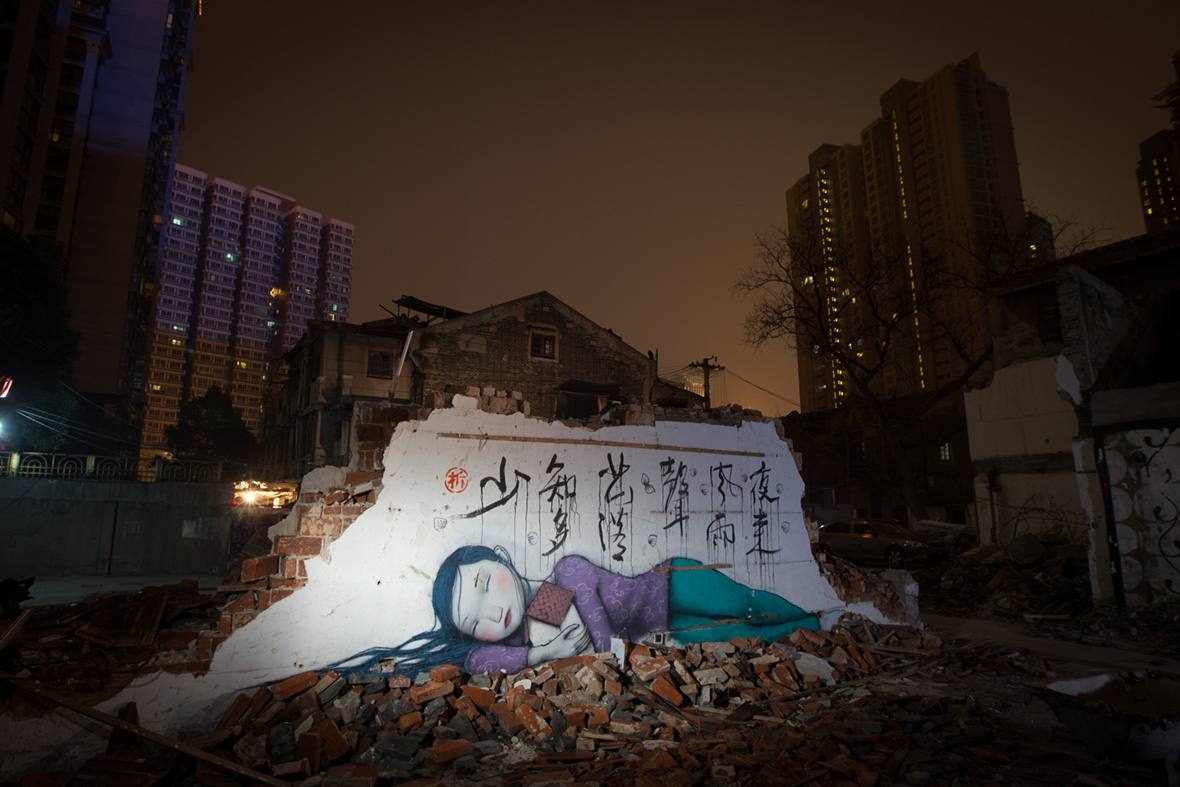
Seth doesn’t spell things out for the viewer. His art is more intelligent than obvious, more suggestive than provocative. He evokes tradition while tactfully alluding to social and political issues, sparking a range of reactions among locals. No matter where he paints, he attributes the ownership and responsibility for his works to the local population. “I leave my work to those who live around it,” he says. “It all belongs to them.”
Seth 不会将作品的内涵直接挑明给观众。他的作品充满智慧,却不是一目了然;更多的是暗示,而非不言而喻。他引用传统,又巧妙地影射社会和政治问题,激起当地观众的反应。无论在哪里画画,他都将他的作品的所有权和责任交托给了当地居民。“我将自己的作品留给附近生活的居民,作品的一切都属于他们。”Seth 说。
Like our stories? Follow us on Facebook and Instagram.
Website: seth.fr
Instagram: @seth_globepainter
Contributor: Tomas Pinheiro
Translation: Olivia Li
Images Courtesy of Julien Malland

